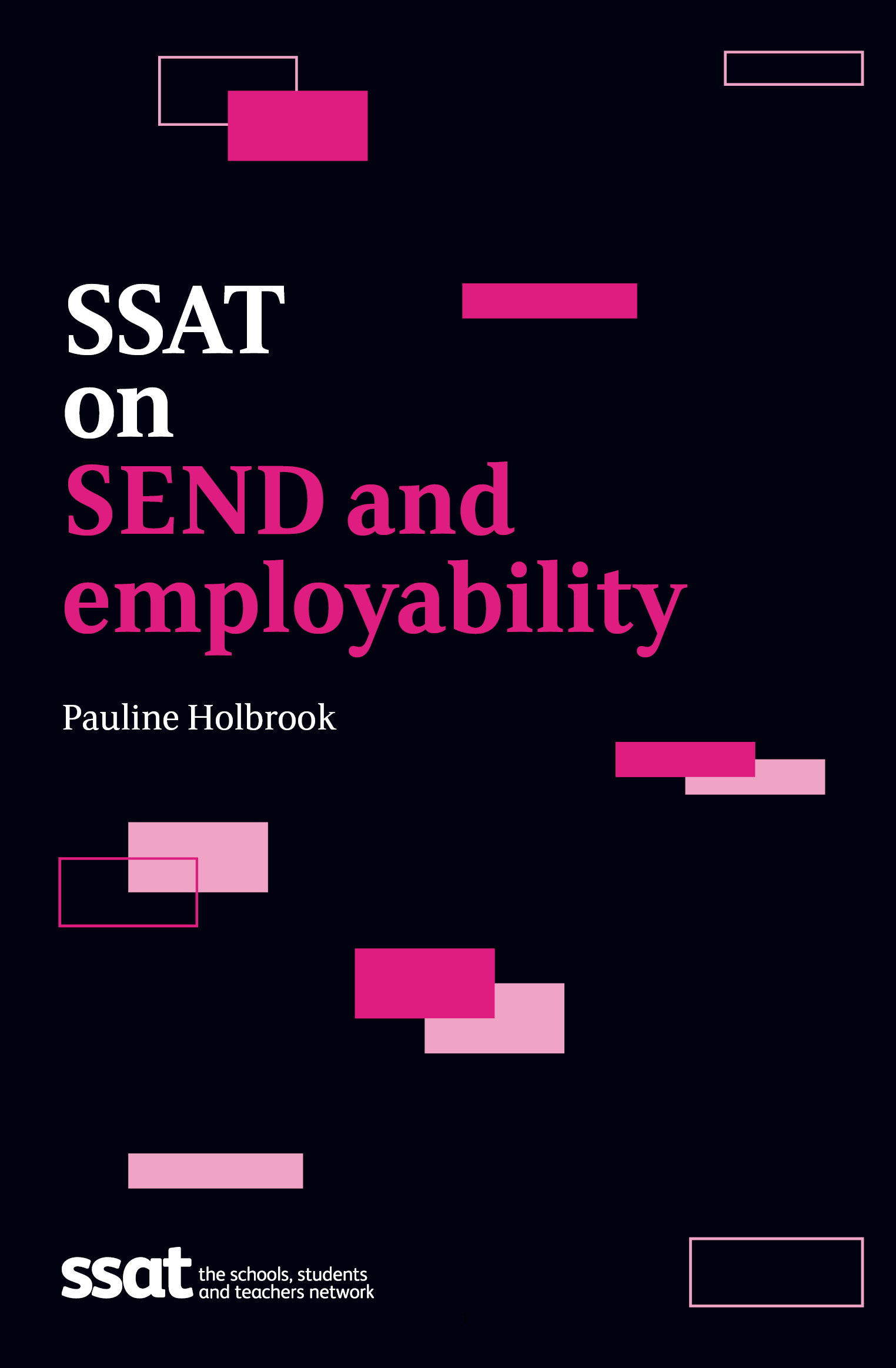
Paul Silvester, headteacher at Newman Community Special School, describes the comprehensive programme introduced in the school designed to enable their students to achieve success.
This article was originally published in the SSAT Journal 17: Spring/Summer 2020. SSAT members can download their digital copy from the Library.
Not an SSAT member? Learn more about becoming a member today.
It doesn’t shock me that the employment rate for special needs adults is as low as 6%, nor that many adults with a learning disability are socially withdrawn and have poor physical and mental health. It doesn’t shock me that the NAO report out in September 2019 highlights the poor outcomes at every level for young people with a learning difficulty or special need. What shocks me is that we as an educational profession are not prioritising addressing this.
There are endless debates about uniform, behaviour, attendance and league tables and yet slowly we see pupils with special needs sink into the dark recesses of educational priorities. Our schools, special and mainstream, must build up skills, resilience and independence in students, and be acknowledged and rewarded when they do so. We must see the value of pupils in the workplace not simply in economic terms but in social impact. Educational provision is not measured solely by a GCSE roll call in the halls of a school in August, but also in celebrating employment of a young person with special needs.
About 18 years ago I heard of a scheme on Merseyside where the local authority had supported the setting up of a fish farm, including a wormery, which used cardboard and access to fresh water. I won’t go into the details but this scheme ended up employing ten people full-time and training each year a further eight. After the initial set-up costs, the scheme was self-sustaining and the trainees had an excellent track record of getting employment after the year-long work experience.
Stages on the route to employment
From that moment I have committed myself to trying to provide a route through to employment for special needs students, which looked at what they can do rather than what they can’t and actually was sustainable and productive. That journey looked at guided learning hours, curriculum, primary experiences, risk-taking parents and carers. And it resulted in the biggest smiles of success possible from young people (and their families) who have gained employment in the real world.
The starting point is not special needs but models that encourage aspiration, support employment initiatives and are sustainable. When I was working in mainstream secondary, one of the government measures was to increase university take-up. Many families without a tradition of university progression did not lack the capacity for their young people to go to university, they lacked the knowledge, understanding and support. The same applies to young people with learning disability and their families. In my mainstream school the funding allocated to supporting a pathway to university started in Y9. In the North East they said this was too late, so invested funds in primary visits and resources, and from that grew an ambition among many to go to university and knowledge of the funding, the application process and the benefits of the experience.
The same is true for learning disability. The pathway for a post-19 employability programme has to start at age nine at the latest. When starting a Project SEARCH programme in Rotherham, we invited 40+ parents/young people to take part: only four said yes (1:10). Conclusion: it is too late to ask in upper secondary, the interest must be built up over many years.
Start with employment as the aim
If you have a culture which looks at employment as a real possibility, it is quite likely that part-time or voluntary routes become alternatives. This does not work the other way around, so a voluntary scheme will not, in my experience, produce a scheme which will lead to sustained employment. It is worth investing in a full-time supported internship scheme as the gold standard, because the other routes will stem from that. At the same time as we started a post-19 offer, we developed an employment-ready primary programme to light the ambition fire. It will not be a 1:10 ratio of engagement in 10 years’ time, I guarantee, and I can show you the take-up of university places in the North East to show you that it is possible to build ambition. Let us have a dialogue about ambition, not about disability, an approach more in common with the rest of the education sector.
Starting a Project SEARCH programme in my previous job taught me a lot about our curriculum and our engagement with employers. As an example: the young people on the internship programme lacked communication skills both in terms of work and in their social life. We reviewed the curriculum and adapted a Lego Therapy concept (a development programme for children with ASD or other social communication difficulties) and devised a Jenga Therapy for post-16 to enhance communication skills. We widened and extended the use of intensive interaction. We employed our own SaLT (speech and language therapy) to develop and support communication. We reviewed the use of Facebook to help develop skills to communicate with a range of adults.
We need to see employment as a challenge worth working towards. It will be a challenge for parents, for curriculum leads – and indeed for the system. A part-time voluntary position will be a success, regular involvement in the local community, a social life with friends, and confidence in social and work contexts will also be a success.
To meet the challenge, my school has wholeheartedly adopted the Duke of Edinburgh bronze, silver and gold schemes, including independent travel. More importantly, we ensure we work with mainstream colleagues, providing opportunities to engage with a broader range of pupils and adults through visits and social activities. All of these help develop employability skills, along with a curriculum that was more skill-focused and enjoyable. The DofE scheme in particular contributed to the success of the internship for the young adults. As important, it enabled their parents and carers to ‘let go’ a bit, to allow space and time for the young people to take risks and to think for themselves.
I have helped set up two 19-25 SEND colleges, to facilitate the pathway to employment. Many FE colleges and colleagues have had vital resources stripped from them and funding mechanisms have restricted what they can deliver. This means that for many a 3½-day offer is classed as a full-time course. The rules on guided learning hours for many SEND students means that they have much more time by themselves, and less support. This often resulted in less resilience and a retreat to the bedroom. After 15+ years in supported education, this is a travesty and a waste. In setting up a SEND college our aim was a 38-week year and a 9-3 skills focused day.
Neglected areas
In the route to employment for these young people there are two areas that often fail to get the attention they deserve: parents and employers.
The regular discourse in the media and in conversations on qualifications, internships, university applications etc, means most people have a knowledge of what is out there in this context. This is not the same for parents and carers of pupils with learning or physical disabilities, nor for employers. While there are problems with the benefits system there is support, for example in the government’s Access to Work programme, and for employers there is the Disability Confident programme, but these need more priority.
For employers, we need to get the positive message about young people with disabilities and their commitment to jobs, which can be a real compensation for less productivity. What engagement are we giving employers to demonstrate the value, positivity and dedication many of our young people with special needs have in the workplace? As a sector, special schools look to safe, contained and simple workplace environments: we often have cafes, run cake stalls, have ‘enterprise’ events when we sell items co-produced with pupils. Sometimes our young people can rise to the challenge of a more varied working environment, particularly if we can give them good experiences of such environments while they are at school. Employers need to know this.
The challenge
While the regulatory regime in recent years has made education seem more judgmental, in terms of employment for special needs pupils we need to work together. The figures tell us that only 6% of people with learning disability are in work, that is fairly well known. What is not well known is the damaging impact on physical and mental health of young adults who are isolated and cut off from their communities. A well-worked employment pathway is not about a gateway to a dead-end job. It is a life-changing opportunity for the young people, their families and the employers themselves. It is a pathway that starts in primary school and is about support tailored, and tapered, to need. It is about opportunity and equality. It is a pathway where success might be sitting with some pensioners in an old people’s home once a week or it might be a 35-hour job. It is about being seen and heard, it is about being valued and valuable.

